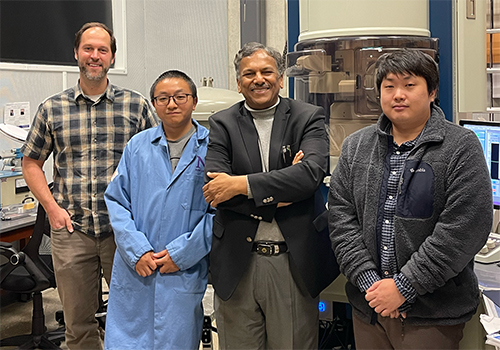High-Tech Methods Unlock the Perplexing Structural Features of a Mineral
Researchers from the NUANCE Center reveal the structural mystery of vaterite CaCO3
- Research associate professor Xiaobing Hu and Professor Vinayak Dravid used atomic resolution imaging technique to determine the accurate structural features of of vaterite CaCO3, a metastable form of calcium carbonate.
- The team found that vaterite CaCO3 has a polytypic structure, meaning its functions can be tailored by localized structural alternation affected by growth environments.
- Determining the actual structure of vaterite CaCO3 could lead to further applications of the mineral in fields as diverse as biology, medicine, materials science, and environmental science.
A form of calcium carbonate, vaterite CaCO3 is an unstable compound that has perplexed researchers for near a century. Investigators have not been able to fully comprehend the compound’s structure, limiting its wide applications. However, vaterite CaCO3’s unique properties hold the potential to impact research in a variety of fields, including biology, medicine, materials science, and environmental science.
Led by Northwestern Engineering’s Xiaobing Hu and Vinayak Dravid and using state-of-the-art technology, a team of scientists has moved closer to cracking the vaterite CaCO3 code.
By utilizing atomic resolution imaging and machine learning assisted theoretical calculations, researchers analyzed vaterite CaCO3’s atomic structure. The team’s results found that the mineral should be classified as a polytypic structure — a type of structure that uses the same building blocks but changes variants as the growth environment is altered, creating different versions with potentially different functions.

“An accurate understanding of the structural features of vaterite could aid geologists in reconstructing the geological history of a region, past environmental conditions of Earth's history, and contribute to a better understanding of biomineralization processes,” Dravid said. “The unique properties of vaterite nanoparticles, such as their biocompatibility and ability to encapsulate and release drugs, also make them potentially useful in pharmaceutical and medical research. The atomic scale insights will help researchers gain a better knowledge of the drug delivery process.”
Hu is a research associate professor of materials science and engineering, and Dravid is the Abraham Harris Professor of Materials Science and Engineering at the McCormick School of Engineering and the founding director of Northwestern University's Atomic and Nanoscale Characterization Experimental Center (NUANCE). They presented their findings in the paper “Unlocking the Structural Mystery of Vaterite CaCO3,” published November 29 in the journal Nature Communications.
“Previously, researchers attempted to determine the structure of vaterite CaCO3 by using bulk measurement techniques such as X-ray diffraction, neutron diffraction, and Raman spectroscopy,” Hu said. “Unfortunately, due to the lack of spatial resolution, the results of those characterizations were inconsistent and, therefore, inconclusive for vaterite.”
Dravid and Hu’s investigation was different. Performed with systematic transmission electron microscopy characterizations, elaborate crystallographic analysis, and machine learning-aided molecular dynamics simulations with ab initio accuracy, their experiments on abiotic, biogenic, and synthetic vaterite — such as lackluster pearls — revealed that vaterite should be regarded as a polytypic structure.

“This polytypic feature is general for all vaterite structures originated from different sources. Although the localized atomical scale stacking could be altered slightly by neighboring environment conditions, the intrinsic building feature of these polytypic system never changes,” Hu said.
Nailing down a compound’s crystal structure is a fundamentally important task because it influences the understanding of physical, chemical, mechanical, and electronic properties of materials. By uncovering the structure of vaterite at the atomic scale, the work from Dravid and Hu allows researchers to perform more accurate crystal structure-related theoretical calculations, which can help scientists reveal the biomineralization pathways of vaterite CaCO3 and extend its functional applications.
Together, these breakthroughs could contribute to vaterite CaCO3 becoming more usable in many different applications. Vaterite’s unique structure, high solubility in water, and porosity properties relative to other crystalline polymorphs make it an ideal functional material for environmental chemistry, bone tissue, and biomedical engineering.
Moving forward, the team will work on uncovering the exact role of the different environmental conditions on the preference of the stacking order in vaterite, which may provide a powerful scaffolding for bone tissue regeneration.